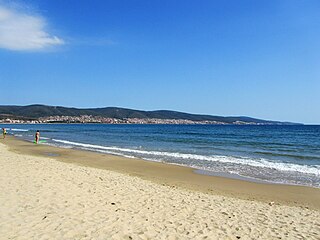
Bulgaria, officially the Republic of Bulgaria, is a country in Southeast Europe. It is situated on the eastern portion of the Balkans directly south of the Danube river and west of the Black Sea. Bulgaria is bordered by Greece and Turkey to the south, Serbia and North Macedonia to the west, and Romania to the north. It covers a territory of 110,994 square kilometres (42,855 sq mi) and is the sixteenth-largest country in Europe. Sofia is the nation's capital and largest city; other major cities include Burgas, Plovdiv, and Varna.

Elias Canetti was a German-language writer, born in Ruse, Bulgaria to a Sephardic Jewish family. They moved to Manchester, England, but his father died in 1912, and his mother took her three sons back to continental Europe. They settled in Vienna.

Sofia is the capital and largest city of Bulgaria. It is situated in the Sofia Valley at the foot of the Vitosha mountain, in the western part of the country. The city is built west of the Iskar river and has many mineral springs, such as the Sofia Central Mineral Baths. It has a humid continental climate. Being in the centre of the Balkans, it is midway between the Black Sea and the Adriatic Sea and closest to the Aegean Sea.

Krum, often referred to as Krum the Fearsome was the Khan of Bulgaria from sometime between 796 and 803 until his death in 814. During his reign the Bulgarian territory doubled in size, spreading from the middle Danube to the Dnieper and from Odrin to the Tatra Mountains. His able and energetic rule brought law and order to Bulgaria and developed the rudiments of state organization.

The Asen dynasty, also called the Asenids founded and ruled a medieval Bulgarian state, called in modern historiography the Second Bulgarian Empire, between 1185 and 1280.

Burgas Province is a province in southeastern Bulgaria on the southern Bulgarian Black Sea Coast. The province is named after its administrative and industrial centre, the city of Burgas, the fourth biggest town in the country. It is the largest province by area, with a territory of 7,748.1 km2 (2,991.6 sq mi) that is divided into 13 municipalities. It has a total population, as of December 2009, of 422,319 inhabitants.

Konstantin Josef Jireček was an Austro-Hungarian Czech historian, politician, diplomat, and Slavist. He was the founder of Bohemian Balkanology and Byzantine studies, and wrote extensively on Bulgarian and Serbian history. Jireček was also a minister in the government of the Principality of Bulgaria for a couple of years.

Neo-Byzantine architecture was a revival movement, most frequently seen in religious, institutional and public buildings. It incorporates elements of the Byzantine style associated with Eastern and Orthodox Christian architecture dating from the 5th through 11th centuries, notably that of Constantinople and the Exarchate of Ravenna.

The Battle of Maritsa or Battle of Chernomen took place at the Maritsa River near the village of Chernomen on 26 September 1371 between Ottoman forces commanded by Lala Şahin Pasha and Evrenos, and Serbian forces commanded by King Vukašin Mrnjavčević and his brother Despot Jovan Uglješa.

Stanislav Manolev is a Bulgarian professional football coach and a former right back.

Dimitar Rangelov is a Bulgarian former professional footballer who played as a forward.

The National Socialist Bulgarian Workers Party was a Nazi party based in the Kingdom of Bulgaria.
Totka Nikolaeva Petrova is a retired female middle distance runner who represented Bulgaria in the 1970s and the early 1980s. She specialized in the 800 and 1500 metres, and won numerous international medals. She is still the Bulgarian 1500 metres record holder.
Koynare is a town in northern Bulgaria, part of Cherven Bryag Municipality, Pleven Province. It lies on the left bank of the Iskar River, at one of the river's meanders. As of December 2009, the town had a population of 4,464.

Antonia Petrova is a Bulgarian lawyer, actress and beauty pageant titleholder who the winner of Miss Bulgaria 2009. She represented the country at Miss World 2009 which took place in December 2009. She crowned her successor Miss Bulgaria, Romina Andonova, in April 2010.
Order, Law and Justice was a conservative political party in Bulgaria. Its main focus is on fighting crime and corruption. It won the minimum ten seats in the National Assembly at the 2009 election, making it the smallest of the six parties in the legislature. Later some of the deputies left the parliamentary group and it broke the minimum of ten, which inevitably made all parliamentary representatives of the party independent deputies.

"Puss in Boots" is a European fairy tale about an anthropomorphic cat who uses trickery and deceit to gain power, wealth, and the hand in marriage of a princess for his penniless and low-born master.

Hólmar Örn Eyjólfsson is an Icelandic footballer who plays as a centre-back for Úrvalsdeild karla club Valur and the Iceland national team. He is the son of Eyjólfur Sverrisson, former Iceland international and manager.
The Bulgarian Social Democratic Workers Party (Broad Socialists) (Bulgarian: Българска работническа социалдемократическа партия (широки социалисти), Balgarska rabotnicheska sotsialdemokraticheska partiya (shiroki sotsialisti)) was a reformist socialist political party in Bulgaria. The party emerged from a division at the Tenth Party Congress of the Bulgarian Social Democratic Workers Party held in 1903 (the other faction forming the Bulgarian Social Democratic Workers' Party (Narrow Socialists)). The 'Broad Socialist' faction had appeared inside the pre-split party around 1900, when Yanko Sakazov had started the magazine Obshto delo ('Common Action'). The Broad Socialists, analogous to the Mensheviks in the Russian Social Democratic Labour Party, argued in favour a broad social base of the party and broad class alliances.
Anarchism in Bulgaria first appeared in the 1860s, within the national movement seeking independence from the Ottoman Empire, strongly influenced by the Russian revolutionary movement. Anarchism established itself as a distinct political movement at the end of the 19th century. It developed further in the 20th century, so much so that Bulgaria was one of the few countries in Eastern Europe where the organized anarchist movement enjoyed a real establishment throughout the country, until the seizure of power by the Bulgarian Communist Party. Under the People's Republic of Bulgaria, the anarchist movement survived underground, but was the victim of severe repression. From 1989, anarchism has been freely reconstituted.

















